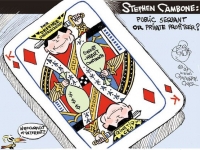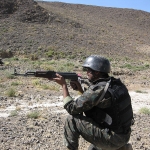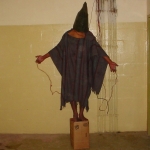QinetiQ Goes Kinetic: Top Rumsfeld Aide Wins Contracts From Spy Office He Set Up

A Pentagon office that claims to monitor terrorist threats to U.S. military bases in North America -- and was once reprimanded by the U.S. Congress for spying on antiwar activists -- has just awarded a multi-million dollar contract to a company that employs one of Donald Rumsfeld's former aides. That aide, Stephen Cambone, helped create the very office that issued the contract.
On January 7, QinetiQ (pronounced "kinetic") North America (QNA), a major British-owned defense and intelligence contractor based in McLean, Virginia, announced that its Mission Solutions Group, formerly Analex Corporation, had just signed a five-year, $30 million contract to provide a range of unspecified "security services" to the Pentagon's Counter-Intelligence Field Activity office, known as CIFA.
According to Pentagon briefing documents, CIFA's Directorate of Field Activities "assists in preserving the most critical defense assets, disrupting adversaries and helping control the intelligence domain." Another CIFA directorate, the Counterintelligence and Law Enforcement Center, "identifies and assesses threats" to military personnel, operations and infrastructure from "insider threats, foreign intelligence services, terrorists, and other clandestine or covert entities," according to the Pentagon. A third CIFA directorate, Behavioral Sciences, has provided a "team of renowned forensic psychologists [who] are engaged in risk assessments of the Guantanamo Bay detainees."
The new CIFA contract with QinetiQ expands work that Analex has provided CIFA and its various directorates since 2003. Under its first contract, according to the QinetiQ website, Analex staffers were sifting through information "from traditional to non-traditional providers, ranging from unclassified through top secret classification using sophisticated information technologies and systems specifically designed by CIFA analysts."
The CIFA contract was awarded just two months after QinetiQ hired Stephen Cambone, the former undersecretary of defense for intelligence and a longtime Rumsfeld aide, as its vice president for strategy. Cambone is the most senior of a savvy group of former high-ranking Pentagon and intelligence officials hired by QinetiQ to manage its expansion in the U.S. market. (See boxes.)
While he was at the Pentagon, Cambone oversaw CIFA and was deeply involved in the Pentagon's most controversial intelligence programs. It was Cambone, for example, who reportedly issued orders to Major General Geoffrey Miller to soften up Iraqi prisoners for intelligence interrogators in Abu Ghraib in 2003. With Rumsfeld, he also set up a special unit within the Pentagon that alienated the CIA and the State Department by running its own covert actions without seeking input from other agencies.
| Duane Andrews Duane Andrews, QNA's CEO and Stephen Cambone's boss, got his baptism in information technology during the first Gulf War in 1991, when he was assistant secretary of defense for communications, command, control and intelligence under Dick Cheney, then defense secretary. His job included managing the Pentagon's Intelligence Surveillance and Reconnaissance operations. |
The new CIFA contract comes on the heels of a series of QinetiQ deals inked with the Pentagon in the booming new business of "network centric warfare" -- the space-age, technology-driven intelligence and warfighting policies established by Rumsfeld and Cambone during their six-year tenures at the Pentagon. Other Cambone-pioneered programs that QinetiQ has won (before he went to work at their Crystal City offices that lie just two miles from the Pentagon) include military drones and robots, low-flying satellites and jamming technologies.
Cambone's appointment at QinetiQ reflects the "incestuous" relationships that exist between former officials and private intelligence contractors, said Steven Aftergood, the director of the Project on Government Secrecy at the Federation of American Scientists and a long-time observer of U.S. intelligence. "It's unseemly, and what's worse is that it has become normal," he told CorpWatch.
Aftergood pointed out the similarities between Cambone and the career trajectory of the current Director of National Intelligence, Michael McConnell. Following McConnell's tenure as director of the National Security Agency, "he went on to receive a seven-figure salary at Booz-Allen Hamilton, a major intelligence contractor," said Aftergood. "And now he's back at the helm of the intelligence community (IC). The problem is not so much a conflict of interest as it is a coincidence of interests -- the IC and the contractors are so tightly intertwined at the leadership level that their interests, practically speaking, are identical."
QinetiQ Evolution
QinetiQ was created in 2001 when the British Ministry of Defense (MoD) split up the Defense Evaluation Research Agency (DERA), its equivalent to the U.S. Defense Advanced Research Projects Agency (DARPA). One part of the company remained inside the MoD, but the other half was sold to the private sector and became QinetiQ.
For its first 18 months, QinetiQ was run by the MoD. But in February 2003, control slipped decisively out of government hands when 33 percent of its shares were acquired by the Carlyle Group, the powerful Washington-based private equity fund with close ties to the Bush administration. Carlyle invested $73 million in the company, and the MoD retained the other 66 percent. In an unusual arrangement, however, Carlyle was granted 51 percent of the voting shares, which meant that the investment fund and its appointed executives had effective control over the company. Carlyle sold off its remaining shares in February 2007, making a $470 million profit on its original investment.
Its initial expansion into the U.S. market was led by its first CEO, Graham Love. A ten-year veteran of DERA, where he rose to the position of finance director, Love had left DERA in the late 1990s by taking one of its divisions private. In 2003, he was brought back to head up QinetiQ's North American operations. With assistance from Carlyle's managers, Love went on the acquisition binge that made QinetiQ what it is today.
In November 2004, it bought Foster-Miller, which builds what it calls "mobile platforms" for the U.S. military, including the Talon robot, a battery-powered machine loaded with night-vision cameras and sensors that can fire both machine gun bullets and anti-tank weapons. Talons are also used on reconnaissance missions to detect mines and disarm roadside bombs in Iraq; more than 600 have been acquired by the Pentagon, according to Fortune magazine. The Foster-Miller website says Talon robots were initially developed with funds from DARPA and have been used in Special Operations missions in Afghanistan, Bosnia and Iraq.
In January 2007, QinetiQ acquired Analex Corporation, an information technology and engineering company that earns 70 percent of its revenue from the Pentagon (after the acquisition, Analex was renamed the QNA Mission Solutions Group). Analex, which has received extensive funding from DARPA for its technologies, also holds contracts with SPAWAR, the U.S. Navy intelligence research center in San Diego, and with the U.S. Army's First Information Operations Command. For the latter, according to Analex, it provides "subject matter experts" in psychological warfare, information security, electronic warfare and general tactics in the war on terror.
With $1.5 billion in defense revenue in 2006, QNA is now the 11th largest U.S. intelligence contractor. The QinetiQ story must be told without speaking to the company, however: QinetiQ officials were not available for comment on Cambone's appointment or any other matter. As for the former undersecretary of defense, "Stephen Cambone is not interested in an interview at this time," Sophie Barrett, QNA's spokesperson, told CorpWatch on January 10.
Stephen Cambone
QinetiQ's main reason for hiring Stephen Cambone was the fact that he had held the unprecedented job of commanding the full spectrum of defense intelligence agencies controlled by the Pentagon, under the 2002 legislation that created his position as the nation's first undersecretary of defense for intelligence. For example he had direct line control over the three national intelligence collection agencies, the National Security Agency (NSA), the National Geospatial Intelligence Agency (NGA) and the National Reconnaissance Office (NRO).
He also oversaw CIFA, which he helped set up in 2003 and transformed into one of the U.S. government's largest collectors of domestic intelligence. Despite occasional criticism from the U.S. Congress for spying on ordinary U.S. citizens, it has thrived at the Pentagon during the administrations of both Donald Rumsfeld as well as Robert Gates, the current secretary of defense.
Cambone was the chief architect of Rumsfeld's so-called "transformation" policies at the Pentagon, which fused data flowing from those agencies into the Pentagon's high-tech war machine. The decisions he made greatly reduced the Pentagon's acquisitions of large weapons systems like aircraft carriers and radically increased its purchases of space-age war technologies such as communications systems, sensors, robots, low-flying satellites and unmanned aerial vehicles (UAVs).
| Other QinetiQ acquisitions In 2005, QinetiQ made one of its most strategic acquisitions: Apogen Technologies, a McLean, Virginia, maker of optical sensors that was deeply involved in "black" (secret) military operations, including anti-submarine warfare and intelligence, surveillance and reconnaissance. At the time, Apogen's chairman was Phillip Odeen, a longtime friend of Frank Carlucci, the Carlyle Group's chairman emeritus. Odeen was a key figure in U.S. intelligence after serving in senior positions at the Pentagon and the National Security Council, where he led the Defense and Arms Control staff under Henry Kissinger. Odeen went on to become CEO of TRW and BDM Inc., two major intelligence contractors that were later acquired by Northrop Grumman. |
It is precisely these technologies that QinetiQ produces. Its work for CIFA, the company said in the release announcing the deal, reflects QinetiQ's role "as a pioneer in planning and executing the protection of government personnel, critical infrastructure and sensitive defense programs." QinetiQ is the largest suppliers of UAVs and robots to the Pentagon and the U.S. intelligence community. It developed the Zephyr, the world's most advanced UAV, a solar-powered drone that can transmit data and pictures continuously for periods up to three months. QinetiQ also specializes in a jamming technology (called "interference protection") that protects satellite systems from outside activity. And the company is a major supplier of acoustic microsensors designed to track the movements of "insurgents" or "illegal immigrants."
For QinetiQ and Cambone, therefore, this is a match made in heaven. Cambone's insights into "national security affairs and priorities," said CEO Duane Andrews, will help shape QinetiQ's ability "to rapidly deliver solutions to the complex challenges that face our defense and intelligence customers." In other words, there was a natural fit between QinetiQ's products and Cambone's inside knowledge of the future plans and strategies behind the U.S. "intelligence enterprise."
Re-Inventing the Pentagon
Cambone's early career was shaped by his deep involvement with technologies associated with missile defense. His first job out of school was as a staffer for the director of Los Alamos National Laboratory, the defense and nuclear power research center in New Mexico. After that, he worked for SRS Technologies, a defense consultancy that worked closely on missile defense.
From 1990 to 1993, Cambone worked under Duane Andrews, his future boss at QinetiQ, as director for strategic defense policy in the office of Secretary of Defense Dick Cheney. There, he advocated for building a laser- and satellite-based missile defense system known derisively by its opponents as Star Wars, a cause he also took up during the Clinton administration as a senior fellow at the Center for Strategic and International Studies.
During the 1990s, Cambone joined the Project for a New American Century (PNAC), the core advocacy group for the cause of neoconservatism, a radical philosophy that views the U.S. as the political savior of humankind, supposedly through "exporting democracy," and advocates the use of force to expand U.S. power and influence around the world. There, he associated with many of the officials he would later serve with in the George W. Bush administration, including Rumsfeld (another Star Wars fan), Cheney and Paul Wolfowitz, who was deputy secretary of defense from 2001 to 2005.
In 1998, Rumsfeld hired Cambone as staff director of a commission he chaired to study the foreign ballistic missile threat. The commission was created by the Republican-led U.S. Congress specifically as a counterpoint to the CIA, which had downplayed the foreign missile threat in a 1997 National Intelligence Estimate. Among the commission's members were Wolfowitz and former CIA director R. James Woolsey, a prominent necon with close ties to the defense intelligence industry. The final report, largely drafted by Cambone, flatly contradicted the CIA by warning of an imminent threat from North Korea and Iran, and became the centerpiece of the Bush administration's initial defense policies.
After Rumsfeld became defense secretary in 2001, he selected Cambone as his special assistant. Cambone quickly became his most trusted trouble-shooter. And in the initial months of the Bush administration, there was plenty of trouble.
Rumsfeld, with Cheney's support, set out from the beginning to "transform" the U.S. military into a high-tech, computerized fighting force designed specifically to shoot down missiles from "rogue states" and defeat counterinsurgencies and other "low intensive" threats to U.S. national security, primarily in the Middle East. None of this sat very well with the uniformed military and the defense industry, both of which were slow to embrace Rumsfeld's network centric policies and the accompanying cuts imposed on Cold War-era weapons such as aircraft carriers and artillery systems. But the grumbling stopped after September 11, which provided the opening for Rumsfeld and his allies in the administration to make intelligence the centerpiece of their new "war on terror."
In 2002, the U.S. Congress embraced a proposal backed by Cheney and Rumsfeld to create a new undersecretary slot at the Pentagon specifically for intelligence, and Cambone was given the job. The position provided enormous powers: under the law, he exercised the Secretary of Defense's "authority, direction and control" over all DoD intelligence, counterintelligence and security policy, plans and programs. That included the key national agencies, which Rumsfeld and Cambone tenaciously fought to keep within the Pentagon's command and control system (for more on this struggle, see Foreign Policy in Focus http://www.fpif.org/fpiftxt/4795). By 2004, according to a profile in the New York Times, Cambone was presiding biweekly conference calls that included the three-star generals and an admiral who ran the Defense Intelligence Agency (DIA), the NGA, the NRO and the NSA. In theory, they also reported to Rumsfeld and Tenet. But Cambone, the newspaper noted, "has made himself their most active overseer."
With their newfound power, Rumsfeld and Cambone set about to give the Pentagon greater authority in the area of human intelligence, traditionally dominated by the CIA. In 2005, Rumsfeld created a new clandestine espionage branch called the Strategic Support Branch, run out of the DIA and under Cambone's control, to end what he called his "near total dependence" on the CIA. By 2005, under the command of Cambone's controversial deputy, Army Lieutenant General William G. "Jerry" Boykin, the support branch was deploying small, covert teams of case officers, interrogators and special operations forces to places like Somalia, Iran and the Philippines, sometimes without contacting the U.S. ambassador or the CIA station chief, to launch covert military operations and prepare for future U.S. action.
| Spying on Anti-War Activists In 2003, the Pentagon's CIFA launched an electronic database called Talon to collect and circulate unverified reports about people and organizations that allegedly threatened Pentagon facilities. These reports were then fed into a database managed by the agency. |
Those were heady days for Cambone: in May 2006, the New York Times would comment that Cambone's "low public profile masks his status as one of the most powerful intelligence officials in the United States." But other publications weren't so kind. Within days of the Times piece, C4ISR Journal, a military publication, described Cambone as a grim and determined ideologue. "'Unpleasant,' 'deeply unpleasant,' 'doesn't joke much' and 'Rumsfeld without the personality' are just some of the ways other reporters and analysts" describe Cambone, the Journal said.
In expanding the power and influence of the Pentagon's special forces, Cambone pushed for policies and technologies that would later make him so useful to QinetiQ, which by 2003 was beginning its expansion in the defense intelligence market. Throughout his tenure at the Pentagon, for example, Cambone pushed for increased spending on satellites, lasers and computer networks that would link the national collection agencies with soldiers and commanders on distant battlefields. In 2004, one year into the intensifying war in Iraq, Cambone proposed spending $30 billion -- one-third of the Pentagon budget for information technology -- on what he called a "transformational satellite system." This was a laser-based project run by the Air Force that would allow the national agencies and the military to share intelligence data and speed its delivery to bomber pilots and ground troops.
During this time, Cambone was also deeply involved in Pentagon planning for a multi-billion dollar "Space Radar" project, a constellation of satellites designed to detect moving and stationary objects from the skies in any weather condition and in darkness. The U.S. Congress only approved a portion of what Cambone wanted for the Air Force and Space Radar projects, however.
In 2006, Cambone presided over an intelligence community review of major intelligence and reconnaissance programs. It concluded that the Pentagon should increase its use of UAVs such as the Global Hawk, which operated at altitudes of 60,000 feet and could stay in the air for 24 hours and more. By this time, the Pentagon was also operating secret "stealth" UAVs as a substitute for satellites. (By 2008, the Associated Press reported in January, the military's reliance on UAVs "that can watch, hunt and sometimes kills insurgents" had soared to more than 500,000 hours in the air, mostly in Iraq. Between January and October 2007 alone, AP found, the Pentagon had more than doubled its monthly use of drones).
Revolving Door
When Cambone's tenure at the Pentagon drew to a close, shortly after the resignation of Donald Rumsfeld in late 2006, the future course of defense spending had already been set: the big money was going to UAVs and low-orbit satellites for the transmission and sharing of intelligence data. (These projects became more crucial in 2007, when the Space Radar was declared a failure and scrapped by Director of National Intelligence Mike McConnell.) And, in response to the increasingly sophisticated tactics of the Iraqi insurgents, millions of dollars were plowed into robots and other technologies aimed at curbing the deadly effects of homemade roadside bombs, that the military has dubbed improvised explosive devices (IEDs).
By joining QinetiQ, less than a year after he resigned from the Pentagon, Cambone has been hired to implement the very policies he helped pioneer at the Pentagon, not as a public servant but as a private businessman benefiting from taxpayer dollars. And with Cambone in the driver's seat in northern Virginia, QinetiQ is set to build on its already thriving business to become one of the premier suppliers of technology to the "intelligence enterprise" that Cambone built.
Tim Shorrock's book on the outsourcing of U.S. intelligence, Spies for Hire, will be published in May by Simon & Schuster.
- 124 War & Disaster Profiteering
- 185 Corruption



